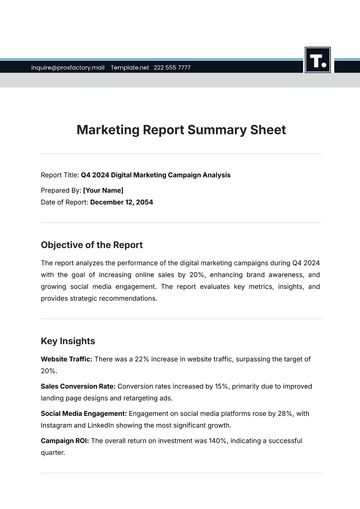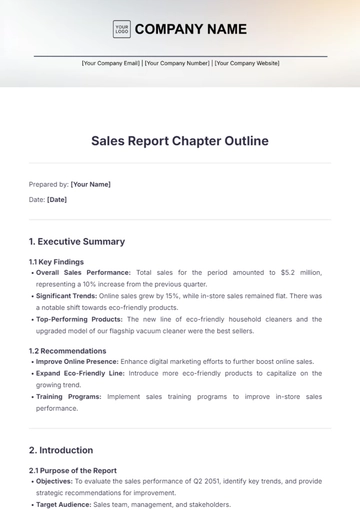Ecommerce Marketing Report
Written by: [Your Name]
Company: [Your Company Name]
Date: [Date]
I. Executive Summary
In today's digital age, ecommerce has become an integral part of retail operations, offering businesses vast opportunities to reach customers worldwide. This report examines the ecommerce marketing strategies and their effectiveness in driving traffic, conversions, and revenue growth on online platforms.
This report provides an in-depth analysis of [Your Company Name]'s ecommerce marketing efforts aimed at driving online sales and enhancing customer engagement. It outlines key strategies, performance metrics, and actionable insights to optimize ecommerce marketing initiatives and achieve business objectives.
II. Objectives
Increasing online sales and revenue.
Improving website traffic and conversion rates.
Enhancing customer experience and satisfaction.
Strengthening brand presence and loyalty in the online marketplace.
III. Market Analysis
An analysis of the ecommerce landscape provides insights into industry trends, competitor activities, and consumer behavior. Emerging trends such as the rise of mobile commerce, the growing importance of personalized shopping experiences, and the increasing demand for sustainable and socially responsible brands are explored. Understanding market dynamics helps identify growth opportunities and areas for strategic focus.
IV. Marketing Strategies
Ecommerce marketing strategies encompass a range of tactics designed to attract, engage, and convert online shoppers. These include:
Search engine optimization (SEO) to improve website visibility and organic traffic.
Pay-per-click (PPC) advertising campaigns to drive targeted traffic and conversions.
Email marketing automation to nurture leads and encourage repeat purchases.
Social media marketing to engage with customers and build brand awareness.
Content marketing initiatives to provide value and establish thought leadership in the industry.
V. Campaign Performance
Evaluating campaign performance is crucial to understanding the effectiveness of ecommerce marketing efforts. By analyzing key performance indicators (KPIs) such as website traffic, conversion rates, average order value, and customer lifetime value, businesses can gain insights into which strategies are driving results and which areas may require optimization. For example, tracking website traffic patterns can reveal peak times for visitor engagement, enabling businesses to schedule promotional campaigns and product launches strategically. Similarly, monitoring conversion rates across different channels and devices can highlight areas for improvement in the purchasing journey, such as optimizing checkout processes or refining product page layouts to enhance user experience.
Furthermore, analyzing average order value and customer lifetime value provides insights into the quality and longevity of customer relationships established through ecommerce marketing efforts. By identifying trends in spending behavior and customer retention rates, businesses can tailor their marketing strategies to maximize revenue opportunities and foster long-term customer loyalty. Additionally, benchmarking campaign performance against industry averages and competitors' metrics can provide valuable context and insights for setting realistic goals and expectations for future marketing initiatives.
VI. Next Steps
Continuously monitor and analyze ecommerce performance metrics to track progress and identify areas for improvement.
Experiment with new technologies and trends to stay ahead of the curve and meet evolving customer expectations.
Collaborate cross-functionally with other departments to ensure alignment and integration of ecommerce initiatives with overall business goals.
Invest in ongoing training and development to build expertise and capabilities in ecommerce marketing and technology.
VII. Conclusion
In conclusion, increased ecommerce marketing efforts have contributed to driving online sales and engagement, positioning for continued growth and success in the digital marketplace. Implementing recommended strategies and initiatives outlined in this report can further optimize ecommerce marketing efforts and deliver value to online customers.
Report Templates @ Template.net






























